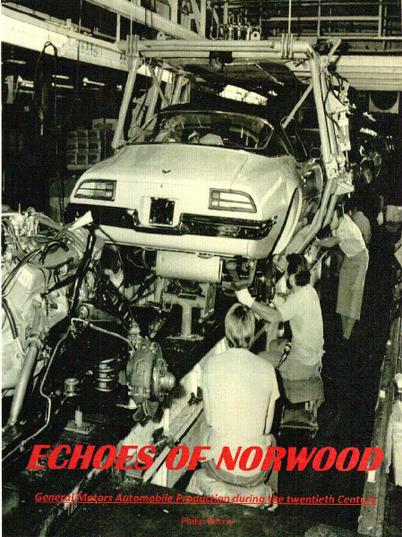
GENERAL MOTORS AUTOMOBILE PRODUCTION DURING THE TWENTIETH CENTURY
ECHOES OF NORWOOD
From the “B” body to the “F” car in never before revealed photographs, production data, and personal recollections, all providing a rare glimpse into the inner workings of the automotive industry during the halcyon era of domestic automotive production
What Echoes is: A first of its kind book that chronicles the operation of a General Motors Corporation assembly plant as witnessed by the workers and managers who were really there. A blockbuster 312 page book a decade in the making-including a stunning 578 pictures and illustrations! Echoes details the assembly process with never before revealed information about regular production cars and many of the special cars built too-including the Pilots, prototypes, COPO’s and Hi Performance models – even Hollywood movie car production. 1923-1987…it was all there- and now the book is finally here.
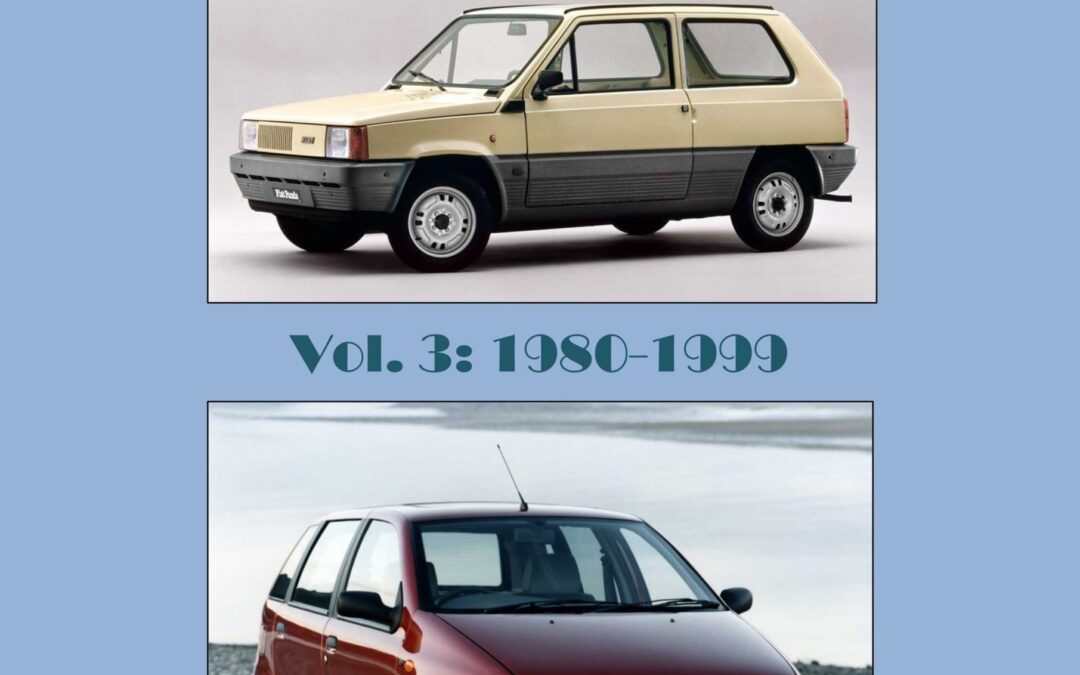
Fiat – Twenty More Years Volume 3 is the final volume on 100 years of Fiat automobiles. A4 format, soft colour covers, 125 pages with 3-4 images per page. Includes Image Credits, References, Bibliography and an Index covering all three volumes, 1899-1999.
This volume covers a period when rapid changes were taking place throughout Europe, including the collapse in 1989 of the USSR’s control of its eastern European empire, the Iron Curtain states of Poland, Hungary, Romania, Czechoslovakia, Bulgaria and the DDR – East Germany. This was almost immediately followed by the collapse of the USSR itself.
New cars were being launched by Fiat, including the iconic Panda, the Uno, Tipo, Regata, Punto, Barchetta, Coupe, Cinquecento and Seicento, Bravo and Brava, Ulysse, Palio and finally the ‘ugly duckling’ Multipla. All Fiats were now front-wheel drive, the old 131 and Argenta rear-wheel drive cars were consigned to history.
Many changes took place within Fiat itself, with Gianni Agnelli searching for a family member able to take over from him when he retired. Several family members were groomed because Gianni’s only son, Edoardo, proved to be a dilettante and incompetent. Agnelli and his Rottweiler, Cesare Romiti, faced down the powerful Italian unions in a battle for control of the company in the face of strikes and social unrest, with Fiat unable to make the numbers of cars they wanted and the quality of those cars suffering as a result of inattention by workers on assembly-line. Automation was progressed as a result, eliminating many jobs. Nevertheless, this twenty-year period produced many sought-after Fiat models which are now regarded as classics.
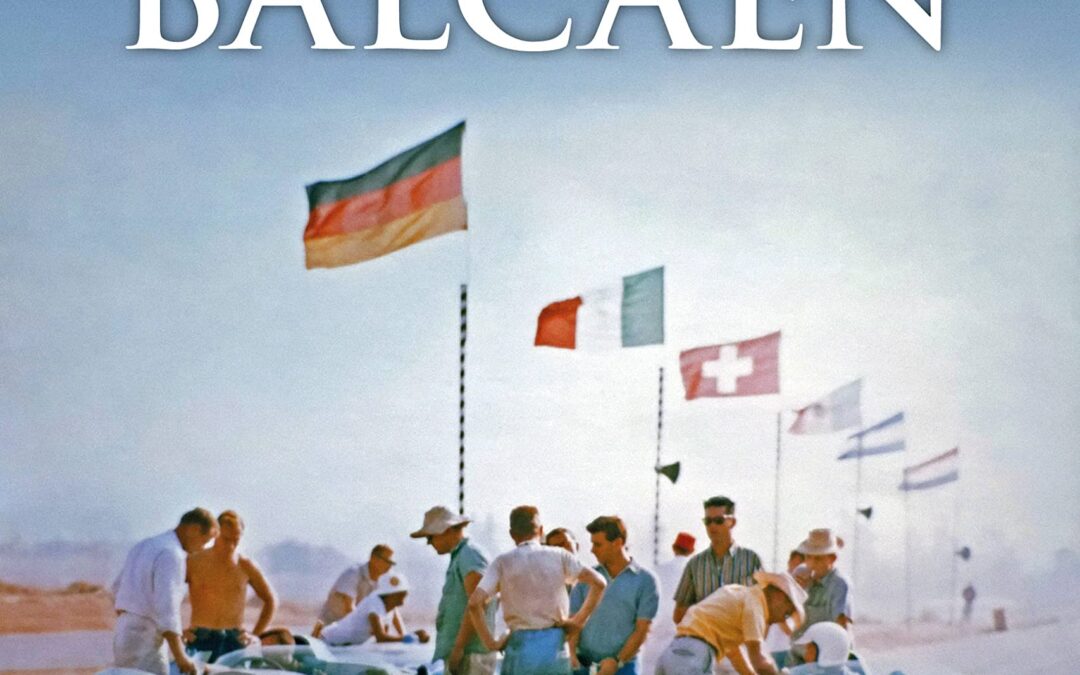
Raoul ‘Sonny’ Balcaen grew up in Los Angeles at a time when it became the epicentre of American motor racing, nurturing a vast talent pool of people whose influence has echoed through to today.
As a teenager, he successfully competed with his home-built Top Fuel dragster during the formative years of the sport. With Lance Reventlow, he worked on the famous Scarab sports cars and was standing in the dyno room when the team’s all-American Formula 1 engine was fired up for the first time. A period as Jim Hall’s crew chief and a close association with Carroll Shelby added to the know-how that guided him towards becoming a successful entrepreneur and led to all that followed.
- Aged 17, Balcaen built his own Top Fuel drag racer, the ‘Bantamweight Bomb’, which he developed relentlessly and drove to many successes.
- His role in the fabulous Scarab sports cars — the landmark all-American racers — and insights into life with their creator, the incomparable Lance Reventlow.
- Working as crew chief to the brilliant Jim Hall, preparing and running his Lotus Eleven and Lister-Chevrolet long before the famous Chaparrals emerged.
- A second spell with Scarab, this time with the Formula 1 project — the first American Grand Prix car — plus a special job for Reventlow converting a Scarab sports racer into a street car.
- Onwards into setting up his own successful business, IECO (Induction Engineering Co), to create and sell high-grade performance and appearance accessories, with Chevrolets — especially Corvair and Vega — featuring strongly.
- His many-faceted dealings with Carroll Shelby, leading to consultancy and even assignments as occasional Shelby American company pilot.
- Along the way we meet many other big names of the era, including Chuck Daigh, Bruce Kessler, Warren Olson, Dick Troutman, Tom Barnes, Phil Remington, Ken Miles, Leo Goossen, Jim Travers, Frank Coon, Ed Donovan and Pete Brock.
This engaging memoir is the very personal history of a momentous time and place in which we meet a who’s who of West Coast road-racing heroes.
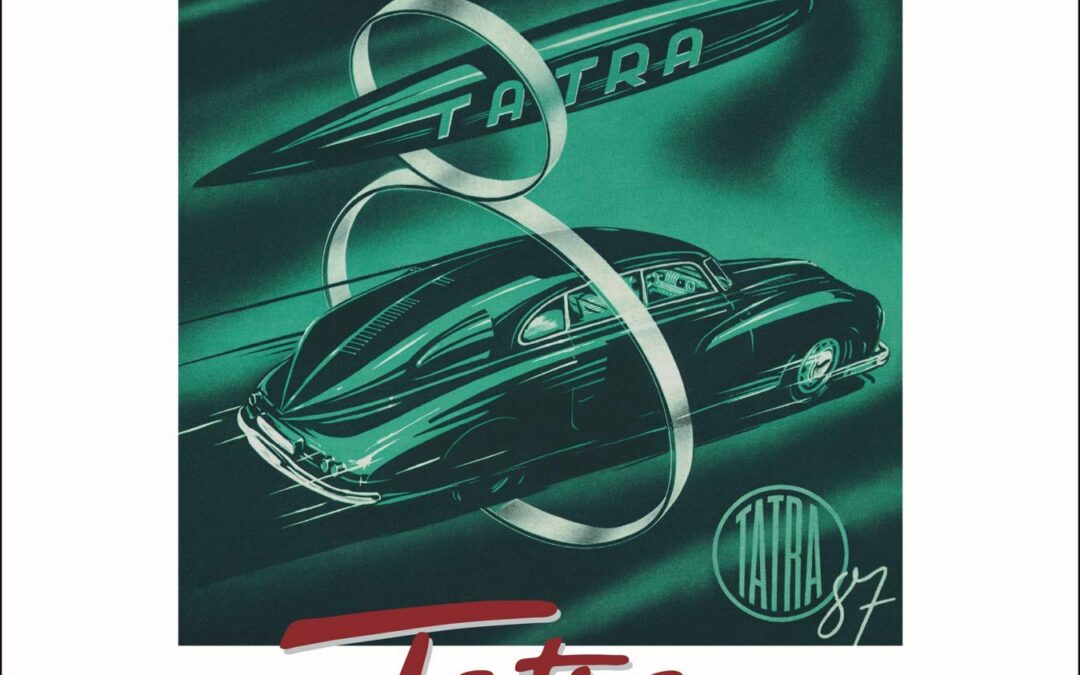
Tatra – The Legacy of Hans Ledwinka is the story of the Tatra company, which originated in the Central European country of Czechoslovakia. It is a tale of great innovation and avant-garde design in automobile engineering. It is also the story of one man – Hans Ledwinka – and his visionary concepts which have become highly influential, although often undervalued, contributions to the development of car technology.
Until now, Hans Ledwinka’s talent has hardly been recognised; in retrospect, he can be judged equal to car designers such as Benz, Daimler and Porsche, whose endeavours have been fully recorded many times over. With his revolutionary Tatra cars, Ledwinka consistently pushed back the frontiers of automobile construction, and it’s certain that without his inspiration, the Volkswagen in its air-cooled rear-engined form would perhaps never have been conceived. This book suggests that Ledwinka played a greater part in this development than has previously been appreciated.
The authors have covered the full history of the Tatra company, which is one of the oldest factories in continuous automobile manufacture, dating back to the 19th century. By doing this, they have placed both Ledwinka and the Czechoslovak Tatra company in their rightful place in the history of car design, and provided a fully comprehensive assessment of the influence of Tatra car designs and their inspired creator.
The text of this larger format 2nd edition has been fully revised and updated since the 1990 edition. This new edition also contains many additional illustrations. The book also has a new foreword, written by Norman Foster, the British architect, and proud owner of a Tatra T87, who pays tribute to the aesthetic qualities of this design classic and captures the fascination of both designers and motor historians with the development of Tatra.
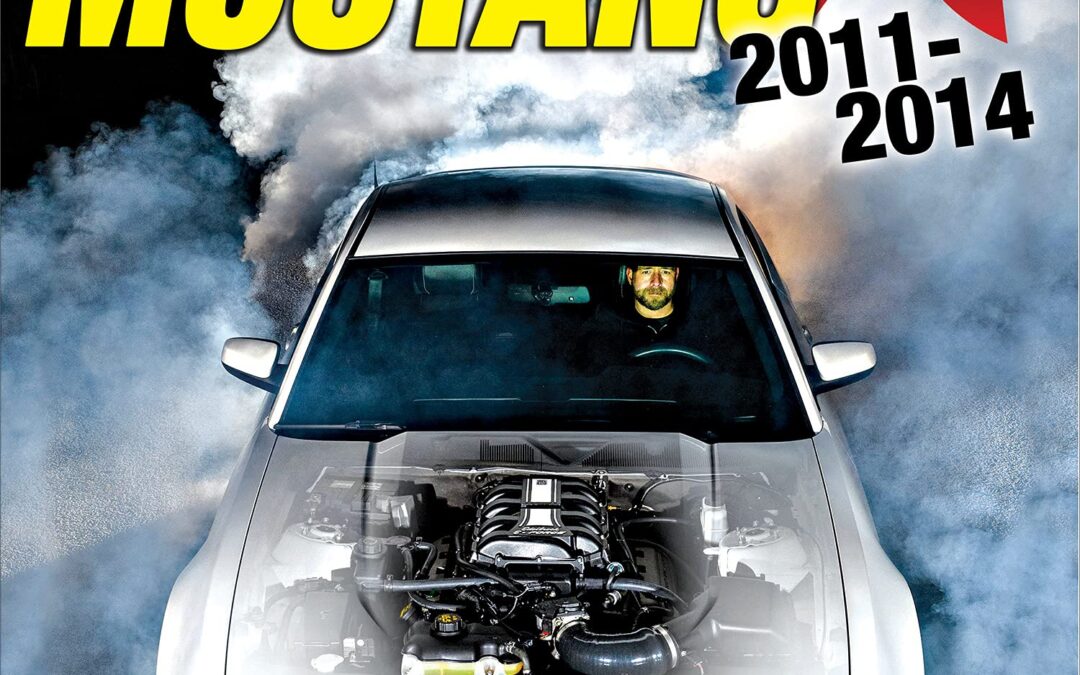
Maximize the potential of your 2011–2014 Mustang with this new book! The Ford Mustang has seen quite an evolution in its 50-plus years of existence. Times change, consumer demands change, and sometimes, you stop and wonder, “How did we get here?” Ford’s designers and its customers were thinking the same thing in the early 2000s. The evolution from the classic original design to the New Edge styling of the 1999–2004 models had some scratching their heads. Ford decided to take a bold turn back to the Mustang’s roots with the fifth-generation model, which made its debut for the 2005 model year and lasted through 2014. Echoing the Mustang fastback design of the 1960s, Ford inspired a path of retro design that the Camaro and Challenger followed shortly thereafter. The move proved incredibly popular with enthusiasts. Of course, with car enthusiasts, the immediate thought was, “How can we make this new Mustang even better?” The big news in 2011 was the introduction of the new 5.0-liter Coyote engine, which was a huge upgrade over the previous 4.6-liter engine. In Ford Mustang 2011–2014: How to Build and Modify, Mustang expert Wes Duenkel takes you through the entire car, system by system, to explore ways to get more performance out the last of the fifth-generation Mustangs. Included are chapters on engine modifications, brake and exhaust upgrades, power adders, chassis and suspension upgrades, cooling system modifications, and EFI and tuning tips. Wheels and tires, differentials, electronic upgrades, and more are also covered. The 2011–2014 Mustangs are finding their way into the affordable category at present with warranties expiring and acquisition costs being very reasonable. Of course, as with all generations of Mustang, there is a robust aftermarket to explore for performance parts and accessories. Ford Mustang 2011–2014: How to Build and Modify covers it all and will help you make your Mustang everything you want it to be.
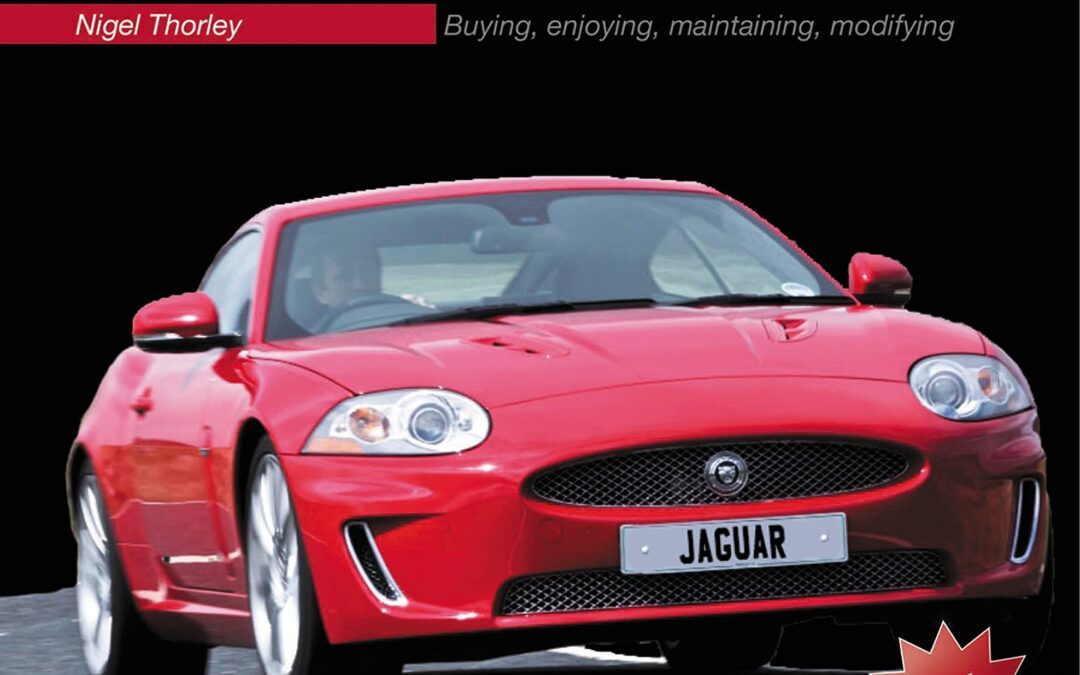
The Jaguar XK was launched to great acclaim in 1996 as the successor to the XJS. Jaguar’s XK sports models were produced from 1996 to 2014 in two distinct forms: the original steel-bodied XK, and, in 2005, the advanced technology aluminium-bodied New XK. Highly significant for Jaguar, these cars reintroduced the world to Jaguar sports car motoring and, in doing so, echoed the success of previous icons, such as the E-type.
The original edition of this book covered just the X-100 (original series) XKs from 1996 through to 2005. This edition, now in paperback, brings the story up to date with the X-150 alloy-bodied cars, from 2006 through to the end of production in 2014. A significantly enlarged work, packed with information and over 130 additional full-colour pictures, this fascinating book is essential reading for all XK owners, prospective owners and enthusiasts – the perfect XK ‘handbook.’
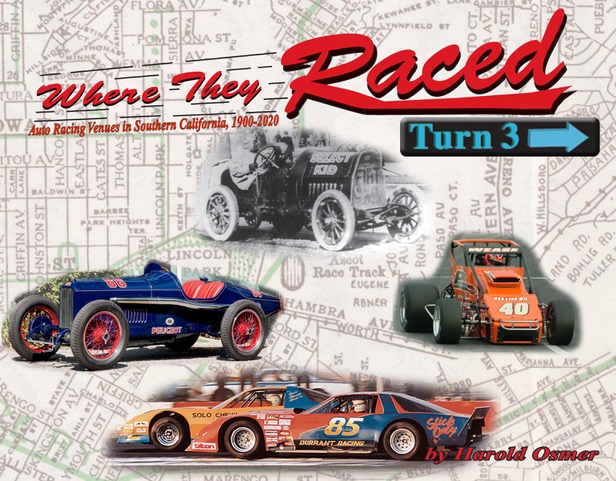
“More auto racing has taken place in Southern California than any other place in the world.”
Where They Raced Turn3 is the long awaited revision of the original classic Where They Raced (out of print since 2012). The history remains unchanged but more images have been uncovered, stories are more detailed, and overall venue coverage is expanded upon.
The first official automotive meet in Southern California took place at Agricultural Park (eventual site of the Los Angeles Coliseum) during Fiesta Week in 1903. This spawned 178 additional auto racing venues ranging from Real Road Races to Board Track Speedways, Short Tracks, Big Ovals, and Drag Strips.
Venues appeared in Santa Monica, Beverly Hills, and on the current sites of Sea World in San Diego and Television City in Los Angeles along with four very different race tracks called “Ascot”(!).
Where They Raced Turn3 traces the rise-fall and rise again of auto racing and its impact on the urban landscape throughout Southern California. This book is less about Who and What raced in favor of the When and (right!) Where they raced. Chances are good that there was an auto racing venue within a few miles of wherever you are in Southern California. Look around, and listen for the echoes of the motors and the cheers from the fans…
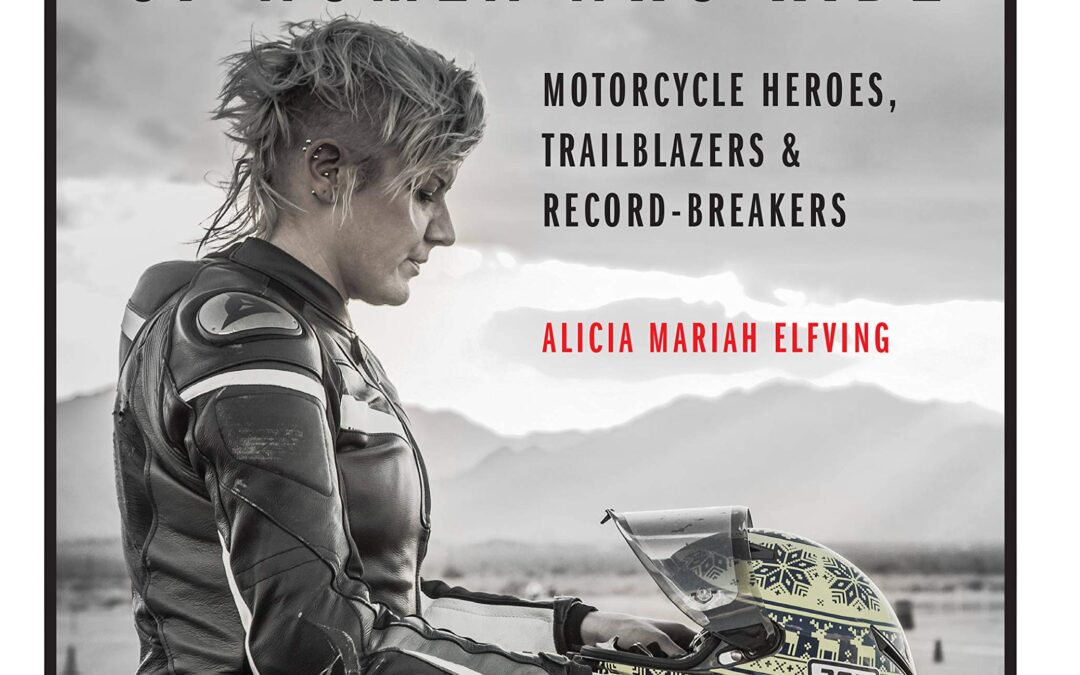
Written and curated by Alicia Mariah Elfving, founder of TheMotoLady.com and the Women’s Motorcycle Show, and arguably the most notable advocate for women in the motorcycling hobby, The MotoLady’s Book of Women Who Ride subverts all the tired women-and-motorcycle tropes, offering the true stories of the women past and present who ride and wrench as well as anyone, proving every bit as indispensable to maintaining and growing a positive motorcycling culture.
Historically, depictions of women in motorcycle culture tend to objectify—from the outlaw motorcycle club “biker babe” to cheesecake photography to posturing celebrities with motorcycles as props. The truth is much different. From the early days of motorcycle culture more than 100 years ago, women have played a central role in making the motorcycle a legitimate form of transportation, recreation, and motorsport.
Elfving presents more than 70 figures in the motorcycle world, from the Americas to Europe and even the Middle East and South Asia—stunt riders, racers, builders, customizers, organizers, and more. Elfving links today’s women motorcyclists with those of the past and illustrates the freedom represented by two wheels, and how motorcycles allow women to transcend cultural expectations confidently. You’ll meet riders such as:
- Sofi Tsingos, who raises money for charities by building and auctioning motorcycles.
- Safety ambassador Brittany Morrow, who found her calling after surviving a high-speed crash with no gear.
- The Van Buren sisters, who in 1916 were among the first motorcyclists to ride coast to coast and the first women to ride to the summit of Pikes Peak.
- The late Jessi Combs, an iconic TV personality, metal fabricator, and land-speed record holder.
Overwhelmingly positive, Elfving instills confidence and can-do rather than providing an echo chamber of common complaints among women in motorcycling. In addition, The MotoLady’s Book of Women Who Ride is illustrated throughout with contemporary and historical photos of the author’s subjects, comprising a beautiful as well as inspiring package.
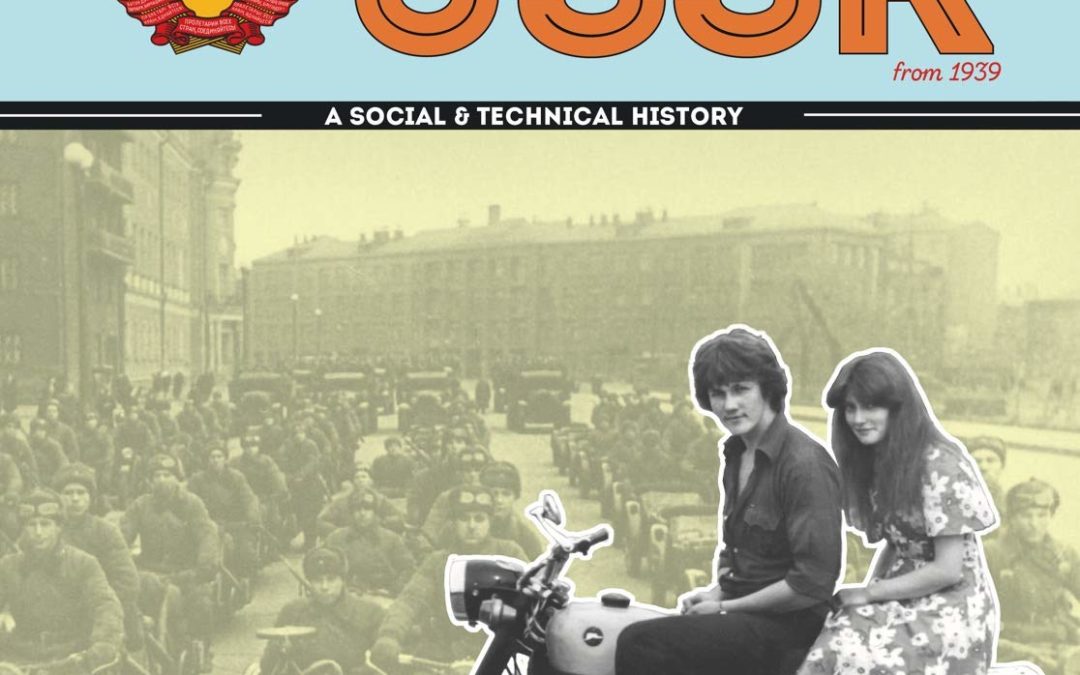
Motorcycles and Motorcycling in the USSR from 1939 provides the first accessible English language account of motorcycles in the Soviet Union. Concentrating on the wartime and postwar period until 1990, prior to the dissolution of the USSR in 1991, it covers the motorcycles produced, and looks at the way in which they were used at home and exported abroad. Chapters cover wartime, models produced, the social character of Soviet era motorcycling, and wide-ranging sport. With planned rather than market-led production based around copies of pre-war German BMW and DKW models, the industry churned out hundreds of thousands of utilitarian and rugged machines that were very different from the more fashion-orientated machines produced in the West. These motorcycles went under the place names of the producing factories: Ishevsk, Kovrov, Moskva, Minsk and, of course, the large flat twins produced in Irbit and Kiev under the Ural and Dnepr names. With a strong emphasis on Soviet era illustrations, the book provides an insight into a life, based on idealism and ideology that has now passed. Photographs and images, many of them from private family collections, show Soviet bikes as well as popular imports Jawa from Czechoslovakia, and Pannonia from Hungary.
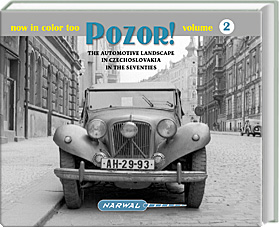
In the early seventies were the streets in Czechoslovakia full of classic cars in their twilight years. Private cars from various origins were kept on the road until their last breath. In the thirties, for example, Czechoslovakia was an industrialized country with an innovative automobile industry. Many of these pre-war cars were still on the road when our photographers visited the country that still laid behind the Iron Curtain. Also a lot of German cars left over by the Wehrmacht, American cars and of course vehicles from ‘friendly’ Russia were subject of our photos. Hundreds of photos of those cars are gathered in the two volumes of POZOR! (Czech for Beware!), many also in colour. Often pictured in splendid settings, such as the classical city of Prague, they form an unique document from the seventies of the last century.
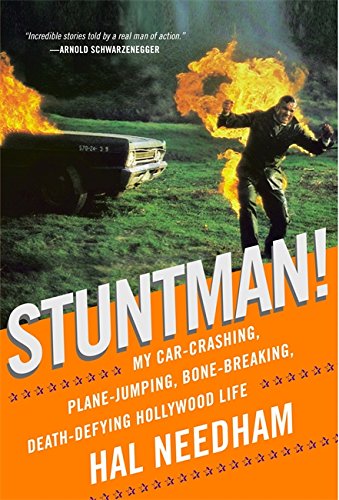
Yep that’s me, Hal Needham, on the cover doing a fire stunt. When you’re on fire you don’t dare breathe because if you do, you’ll suck those flames right down your throat. I was Hollywood’s highest paid stuntman so I should know.
I wrecked hundreds of cars, fell from tall buildings, got blown up, was dragged by horses, and along the way broke 56 bones, my back twice, punctured a lung and knocked out a few teeth…I hung upside down by my ankles under a bi-plane in The Spirit of St. Louis, jumped between galloping horses in Little Big Man, set a world record for a boat stunt on Gator, jumped a rocket powered pick-up truck across a canal for a GM commercial, was the first human to test the car airbag-and taught John Wayne how to really throw a movie punch.
Life also got exciting outside of the movie business. I had my Ferrari stolen right from under my nose, flew in a twin-engine Cessna with a passed out pilot, rescued the cast and crew from a Russian invasion in Czechoslovakia, and once took six flight attendants on a date. I owned the Skoal-Bandit NASCAR race team, the sound-barrier breaking Budweiser Rocket Car and drove a souped-up, fake ambulance in a “little” cross-country race called The Cannonball Run, which became the movie I directed by the same name. Oh yeah, I also directed Smokey and the Bandit, Hooper and several other action/comedy movies that I liked a bunch.
I was a sharecropper’s son from the hills of Arkansas who became a Hollywood stuntman. That journey was a tough row to hoe. I continually risked my life but that was the career I chose. I was never late to the set and did whatever I had to do to get the job done.
Hollywood’s not all sunglasses and autographs. Let me tell you a few stories…

Three quarters of a million people are in a plane somewhere right now. Many millions travel by air each day. For most of us, the experience of being in an airport is to be endured rather than appreciated, with little thought for the quality of the architecture. No matter how hard even the world’s best architects have tried, it is difficult to make a beautiful airport.
And yet such places do exist. Cathedrals of the jet age that offer something of the transcendence of flight even in an era of mass travel and budget fares. Here are twenty-one of the most beautiful airports in the world.
The book features:
Wellington International Airport, ‘The Rock’ shaped like the dangerous cliffs of a local legend
Kansai International Airport, Renzo Piano’s gigantic project built on three mountains of landfill
Shenzhen International Airport, a manta ray shaped terminal putting this booming region on the map
Daocheng Yading Airport, the world’s highest civilian airport in the middle of the Tibetan mountains
Chhatrapati Shijavi International Airport, rising from the slums of Mumbai like a Mogul palace
Queen Tamar Airport, a playfully iconic modern airport nestled in the mountains of Georgia
King Abdulaziz International Airport, the gateway to Mecca resembling a Bedouin city of tents
Pulkovo Airport, mirroring the city of St Petersburg with bridges, squares and art
Berlin-Tegel Airport, ultramodernity, 1970s style
Copenhagen Airport, an icon from the golden age of air travel
Franz Josef Strauß Airport, sober and easy to negotiate, Munich’s model airport
Paris Charles du Gaulle Airport, the brutalist icon that launched the career of airport architect Paul Andreu
London Stansted Airport, Norman Foster’s return to the golden age of air travel
Lleida-Alguaire Airport, a relic of Catalonia’s early 21st century building boom
Madrid-Barajas Airport, Richard Rogers and Antonio Lamela’s calm, bamboo-panelled Terminal 4
Marrakesh Ménara Airport, a blend of 21st century construction and traditional Morrocan design
Santos Dumont Airport, Rio de Janeiro’s modernist masterpiece
Carrasco International Airport, Rafael Viñoly’s design inspired by the sand dunes of his native Uruguay
Malvinas Argentinas International Airport, echoing the mountains and glaciers of Tierra del Fuego
John F Kennedy International Airport, Eero Saarinen’s glamorous jet-age TWA terminal
Spaceport America, a vision of the future in the New Mexico desert

Tatra – The Legacy of Hans Ledwinka is the story of the Tatra company, which originated in the Central European country of Czechoslovakia. It is a tale of great innovation and avant-garde design in automobile engineering. It is also the story of one man – Hans Ledwinka – and his visionary concepts which have become highly influential, although often undervalued, contributions to the development of car technology.
Until now, Hans Ledwinka’s talent has hardly been recognised; in retrospect, he can be judged equal to car designers such as Benz, Daimler and Porsche, whose endeavours have been fully recorded many times over. With his revolutionary Tatra cars Ledwinka consistently pushed back the frontiers of automobile construction, and it’s certain that without his inspiration, the Volkswagen in its air-cooled rear-engined form would perhaps never have been conceived. This book suggests that Ledwinka played a greater part in this development than has previously been appreciated.
The authors have covered the full history of the Tatra company, which is one of the oldest factories in continuous automobile manufacture, dating back to the 19th century. By doing this, they have placed both Ledwinka and the Czechoslovak Tatra company in their rightful place in the history of car design, and provided a fully comprehensive assessment of the influence of Tatra car designs and their inspired creator.
The text of this larger format 2nd edition has been fully revised and updated since the 1990 edition. This new edition also contains many additional illustrations. The book also has a new foreword, written by Norman Foster, the British architect, and proud owner of a Tatra T87, who pays tribute to the aesthetic qualities of this design classic and captures the fascination of both designers and motor historians with the development of Tatra.
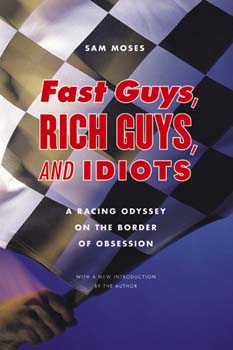
Sam Moses, a motorsports writer for Sports Illustrated, was assigned to go racing and write about what happened. Fast Guys, Rich Guys, and Idiots is a personal odyssey that peers over the cliff of change and into the pit of obsession. From small-time races to glittery grands prix, it lays bare the greed, lust, and desperation of every driver for time behind the wheel and a faster car. It explains the perfectionism behind taking a turn at the limit and describes the intoxicating thrill of stealing down the Daytona backstraight at nearly two hundred miles an hour.
The core of Moses’s story takes place in the heartland of stock car racing, there he finds a spot on a team in Ether, North Carolina. The team’s owner is a tough Louisiana oil man, its crew chief a lanky, laconic Texan, and its number-one driver a hairy-chested leadfoot who learned fast driving on backwoods Georgia roads, delivering beauty supplies in his Mustang. Crashes echo throughout the tale that follows, five of them the author’s own.

Whether it’s a new Formula One V10 wailing at almost 20,000rpm or the metallic howl of a classic V12, there is nothing on earth like the sound of a racing car at full speed – and if it’s a bright red Ferrari screaming by flat-out, then so much the better.
“Red Noise” has been produced by broadcast audio specialists to bring those sounds right into your living room, your car or your stereo headphones. It utilises incredible recordings made in areas that the general public can never hope to reach….with microphones mounted on the trackside guard rails, and even from right inside the famous Monaco tunnel!
Listen to the sounds of Ferraris, Maseratis and Alfa Romeos spanning more than 75 years of motor racing history and featuring the world’s most famous Grand Prix cars.
This is a genuinely unique aural experience, so push the ‘play’ button, close your eyes and let your imagination and “Red Noise” take you right to the trackside.
Ferraris – Old and New1. See Red, Hear Red! The Vintage Sports Car Club stages an annual meeting at Donington Park that is themed around Italian racing cars. ‘See Red’ is the name of the VSCC meeting and we went there to give you the chance to ‘Hear Red’ ! First there’s the harsh engine notes of a 1980 Ferrari 312T5 ‘flat-12’ (a car actually driven by Gilles Villeneuve!) This is followed by an ex-Michael Schumacher team car from 2002 which we hear idling, picking up the revs, warming up, then finally pulling out of the pits with that distinctive V10 howl.
2. Monaco Ferrari Parade There was a fantastic gathering of Ferraris at the Monaco Historic Grand Prix in 2004. We were there to record all those incredible sounds! Cars ranged from the very first Type 125 1500cc supercharged GP car as driven by Alberto Ascari to a 21st-century Schumacher V10. In fact, there were no less than five vee-tens on hand – two Eddie Irvine cars from 1997 and three Schumacher cars from 1998/99 and 2000.
3. Picking up the Pace More from La Piscine as the real demonstration got under way and the cars picked up to racing speeds. No wonder the Italian commentator was getting excited!
4. Old and New in Action Old and new cars take La Piscine en masse. The field includes both four-cylinder and V12 cars from the ‘fifties, a 3-litre Type 312 V12 from 1968 and no less than seven Type 312 flat-twelve ‘boxer’ engine cars. From more recent times there were V12s as driven by Michele Alboreto in 1987, Nigel Mansell in 1990 and Alain Prost in 1991. And last, but very far from least, were the five Irvine and Schumacher vee-tens! They all mean music to the ears of the ‘Ferraristi’….
5. More from Monaco More ‘red noise’ from the Monaco 2004 Ferrari tribute high-speed demonstration laps. Similar to the previous tracks but too good to waste – especially as we were recording with microphones actually right on the Monaco trackside guard rails!
6. Flat-Out Red! And now for a change of recording point – here are Ferraris- old and new – passing at speed on the Monaco start/finish straight.
7. Generations Apart A 1999 ex-Schumacher Ferrari V10 takes La Piscine in conjunction with a rear-engined Ferrari 246 ‘Dino’ V6 that Italy’s Lorenzo Bandini took to second place here at Monaco in 1966. Then comes a 2.5 litre Ferrari Type 625 – the car that Frenchman, Maurice Trintignant, won Monaco with in 1955. The old front-engined ‘four’ takes La Piscine in conjunction with another modern Ferrari V10.
8. The Ferrari Type 312 V12 Sit back and listen to the first Ferrari Type 312 warming up and blasting through the Monaco tunnel.
9. Jackie Ickx Remembers Belgian Grand Prix and Le Mans star, Jackie Ickx, was a young Ferrari driver in the early nineteen-seventies. He remembers those times for us and tells us what it was like to race at Monaco back then.
10. Flat-Twelve Ferraris Not until Ferrari re-designed its 3-litre V12 did they start scoring World Championship successes again. It powered Niki Lauda to world titles in 1975 and 1977, as well as Jody Scheckter in 1979. The engine had a distinctly harsh note. We hear it warming up at Monaco, then making several echoing passes through the Monaco tunnel and, finally, negotiating the La Piscine sequence of tight turns.
11. The ‘Other Flat-Twelve’ There was another ‘flat-twelve’ built in Italy during the seventies, this one by the Alfa Romeo team in Milan. This is what that car would have sounded like back then, warming up and then blasting off, flat-out.
12. The Last F1 Vee-Twelves Ferrari stuck with V12 engine power right through the mid-nineties with Frenchman, Jean Alesi and Austria’s Gerhardt Berger driving the Type 412 team cars until the end of the 1995 season. By then, it was obvious that the V10 layout was definitely the most efficient of all of the Formula One options. Even so, the heavier, longer V12 took the 412 to a number of GP wins – and it sounded great in the process!
13. Into the 21st Century This is the unmistakable sound of V10-powered Ferraris howling by our microphones on the trackside barriers. First we hear some individual passes, then a whole group of vee-tens finish the track. These are all cars driven by either Michael Schumacher or Eddie Irvine between 1997 and 2000.
Maserati from Modena
14. Vintage Red Maserati is one of the oldest names in motorsport. Listen to a couple of vintage Maserati racers warming up – a four-cylinder 4CLM from 1939 and a six-cylinder 6CM from the 1937 season. These supercharged 1500cc cars would have raced in the ‘voiturette’ class – the nineteen-thirties equivalent of the Formula Two (or GP2) category.
15. A Fifties Favourite The six-cylinder Maserati 250F was one of the favourite 2.5 litre Formula One cars of the fifties – both with the fans and with its drivers. Listen to a group of them fire up, pull out of pits and then pass by on a flying lap.
16. Maseratis En Masse! A full field of twenty cars in a ‘Maserati-only’ race at the Vintage Sports Car Club’s ‘See Red’ event at Donington Park. They range from pre-war four, six and eight-cylinder supercharged cars to a whole pack of what is one of the most-admired Grand Prix cars of all time, the six-cylinder Maserati 250F. Hear them on the parade lap, and in race action through Redgate Corner.
17. Maserati at Monaco The throaty sound of a six-cylinder Maserati 250F as it warms up, followed by the rumble and the roar of a full field of ‘fifties Formula One cars on their warm-up lap.
18. Monaco Shark Hunt! The three-pronged trident is famous as the weapon of Neptune, or Poseidon – the God of the Sea and it has also always been the emblem of Maserati. So it’s perhaps appropriate that we hear a pack of 250F Maseratis chasing a Ferrari Type 555 ‘Squalo’ – or ‘Shark’ through the tight left-hander before Monaco’s Rascasse hairpin.
19. GP Rivals Warm Up A Bugatti Type 35 warms up in the Monaco pits. It carries the racing blue of France where the cars were built. Then an Alfa Romeo P3 is push-started into life and joins the mechanical chorus.
20. Right on the Rail! A full field of more than thirty great cars of ‘the golden age’ rumble around on a warm-up lap, take the start and attack the opening laps of a race around the Monaco streets. You are right up with the action thanks to our stereo microphones positioned right on the trackside safety barriers.
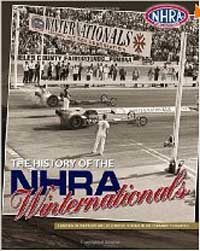
Since 1960, the first official rumble of high-performance engines has echoed across Southern California’s Fairplex at Pomona, signaling not just the beginning of another year of exciting NHRA Drag Racing, but also the launch of a thousand dreams of glory. From Don Garlits’ first winged dragster in 1963 or his revolutionary rear-engine Top Fueler in 1971 to Bill Jenkins’ tube-framed Vega Pro Stocker and Kenny Bernstein’s aerodynamically enhanced Budweiser King Funny Cars, the Winternationals has always been fertile ground for the birth of new technologies and the launchpad for drivers to stake their claims at one of NHRA’s most majestic events. In 2010, the Winternationals celebrates its Golden Anniversary. In these pages, you’ll relive the excitement and wonder of every Winternationals and explore in-depth the many facets of the event’s intriguing history, from the heroes of the dragstrip to the machines they drove to glory.
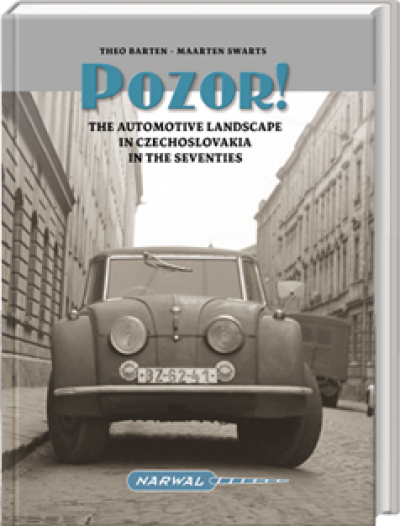
In the early seventies the authors (professional photographers) visited Czechoslovakia in search of classic cars in their twilight years. What they found on the streets of Prague and other cities was forty years of automotive history. Private cars of various origins were kept on the road until their last breath. In the thirties Czechoslovakia was an industrialized country with an innovative automobile industry. Many of these prewar cars were still to be found on the streets in the nineteen seventies.
In addition to the Czech cars many examples of other European, Russian and even American cars were seen.
Hard cover, Over 125 high quality photos in sepia tones.
Autobooks-Aerobooks 2900 W. Magnolia Blvd. Burbank, CA 91505 (818) 845-0707 Hours: Tuesday-Friday 10:00 AM – 6:00 PM Saturday 10:00 AM – 6:00 PM Closed Sunday and Monday Accept Credit Cards gift cardYES, We have Gift Cards - Click Here AUTOBOOKS IS OPEN...



















